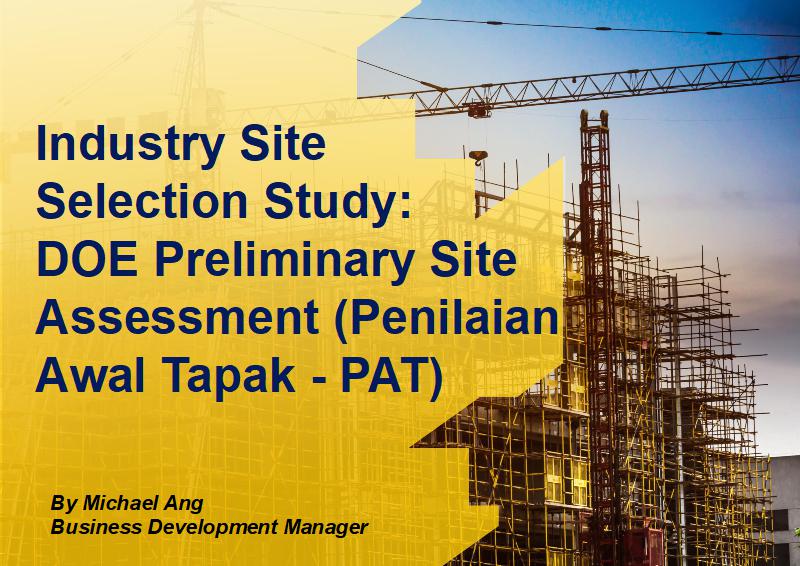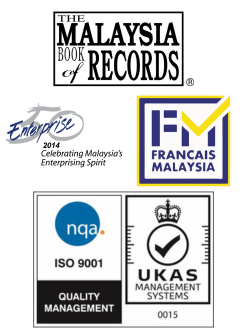Author: Michael Ang | 24 June, 2021
Most of the project proponents (owners or developers) evaluate the suitability of a project site for industry from the accessibility and commercial perspective, e.g. accessibility to customer, suppliers, and workers, availability of transportation infrastructure, and affordability of land and other costs associated with the use of land and its services. The project proponents always tend to neglect the environmental impact of the industry and the compatibility with the surrounding site. The compatibility of the industry with the adjacent land use and sufficiency of the buffer distance are also important criteria in site selection as they provide more environmental management options which would minimise the investment into pollution control measurements for the project.
Preliminary Site Assessment (Penilaian Awal Tapak – PAT) is a process to ensure the proposed site for a new industrial project is being assessed and screened at the early stage before submitting the development order or even before land purchasing. The State Department of Environment (DOE) would evaluate the proposed site whether suitable for the proposed industry. Environment Impact Assessment (EIA) might be required by DOE if found necessary after the PAT process. The PAT also helps project proponents in selecting the best suitable location or site for their developments. It is also one of the mandatory documents required by local authorities when project proponents submit for the Development Order approval.
Manufacturing industries could cause a wide range of environmental concerns includes air, noise, fumes, smoke, vibration, odour, and water pollution, risk of death or injury due to fire and explosion, and risk of health due to toxic and hazardous chemical wastes release. The severity of the concerns is influenced by several factors such as the type of raw material used, the type of process technology adopted, the type of equipment or machine used, the type of control system applied, the operation and management practices implemented, and the type of training provided for workers. Generally, heavy industries would create higher environmental hazards compared to light and medium industries.
In order for the project proponents to select a suitable site for their proposed development, they are advised to shortlist more than one site as their option. All shortlisted sites shall be evaluated if the sites comply with the general guidelines for the sitting of the project. The project proponents are also advised to conduct a due diligence audit if the shortlisted sites are not ‘brownfield site’ to determine any contamination from the past use or operations on the site. To avoid any unnecessary hassle in the future, the project proponents are highly advised to submit the PAT and obtain DOE’s views and advice on the selected site prior to full commitment to purchase the site.
It is highly advisable for the project proponents to engage a professional consultant in assisting them to submit for the PAT. The application shall be completed with PAT form, site and location plan, project layout plan, land use analysis map, project description, and relevant information about pollution prevention and control. Modelling studies shall be attached, where appropriate and required, for those industries identified as highly hazardous.
Several criteria for site suitability acceptability shall be considered as follows:
- The proposed land use shall be suitable and not in conflict with the proposed usage as gazetted in the Structure or Local Plan (RT), or other approved land use plans by relevant authorities. It is preferable to be located within the designated and approved industrial estates or on industry land;
- The proposed land use shall compatible with the adjacent land use as gazetted in the Structure or Local Plan, or other approved land use plans by relevant authorities. It is also advised to avoid an area in which an operation could potentially impact the environmentally sensitive areas located downstream or the adjacent lands;
- The proposed site shall generally comply with the desired buffer zone or setback requirements. The primary buffer shall be sufficient to mitigate those environmental concerns by an adequate separating buffer from the sensitive receptor;
- The proposed site shall have good road infrastructure which allows for easy site access without passing through sensitive receptors such as residential area, hospitals, and schools;
- The proposed area shall be served with sufficient and proper utility supplies and appropriate waste management facilities, and proper drainage for rainwater conveyance;
- The impact of the additional pollutant capacity shall not be exceeding the national ambient air and water goals; and
- The adoption of the process technology, pollution control prevention, and control measures proposed.
State DOE would support the proposed development if found that the proposed site is suitable for the proposed purposes. Vice-versa, State DOE would not support the proposed development if found that the proposed development is not in compliance with the DOE’s requirements.
CASE STUDY 1:
Steve runs a steel fabrication business. He had the intention to expand his business by increasing the production area. Coincidently, a property negotiator contacted him and asked if he is interested in industrial land, and the price offered was below the market rate. Without further due diligence, he had excitedly agreed with the deal.
After the transaction was completed, Steve planned to build the steel fabrication plant on the purchased land. He engaged professional consultant for the designing and handling authority submission for building plan approval. However, the engaged professional consultant found that the construction of a steel fabrication plant on this land is not permissible after obtaining comments from DOE for the PAT submission. The reason that the proposed project was being not supported due to the proposed project is not compatible with the land use. The industrial land Steve purchased is cheap but the industrial land is only permissible for light industry usage. The steel fabrication plant is categorised as a medium industry, thus the proposed project is not supported by DOE due to non-compliance with DOE requirements. Subsequently, without the support from DOE, the Development Order was rejected by Planning Department for the proposed activity.
CASE STUDY 2:
A foreign multinational corporation planned to invest in a waste recycling factory in Malaysia. The Group had rented a factory located at a medium industry land and set up the recycling facilities before applying for their business license. They started to apply for the business license after all the setup had been completed. However, they failed to obtain their business license from the local authority as the application was not supported by DOE.
The application was not supported by DOE mainly due to the nature of its business or industry. The waste recycling industry is only allowed to be operated in a heavy industry area due to environmental concerns. The pollutants generated from the industry are hazardous and thus DOE request a bigger buffer distance between the project site and the adjacent sensitive receptors. Due to the non-compliance, the Group was forced to dismantle all the setup and relocate the factory to the designated heavy industry zone in order to continue the operation.
CONCLUSION
It is crucial for the project proponents to conduct necessary due diligence and PAT submission to DOE prior to full commitment to purchase a project site. It would be a disaster for the project proponents if the intended industry is not compatible or suitable with the land purchased. In most of the case, it is hard for the project proponents to convince DOE for the approval and eventually the purchased land would be left undeveloped and face value depreciation. Thus, investing a small upfront amount for engaging a professional consultant in advising the site suitability at the early stage is definitely worthwhile to avoid a potentially huge loss in the later stage.
Michael Ang
Business Development Manager
IPM Professional Services Sdn Bhd
Reference:
1. Department of Environment. (2012). GUIDELINES FOR SITING AND ZONING OF INDUSTRY AND RESIDENTIAL AREAS (2nd ed.). Retrieved on 23rd June 2021 from http://www.doe.gov.my/eia/wp-content/uploads/2012/02/Guidelines-For-Siting-and-Zoning-of-Industry-and-Residental-Areas-2012.pdf

